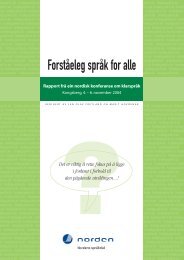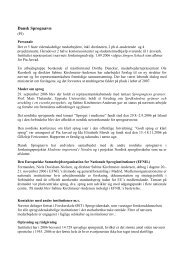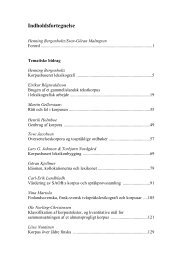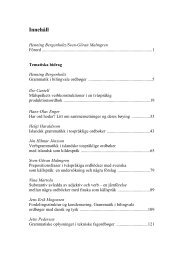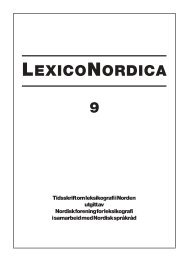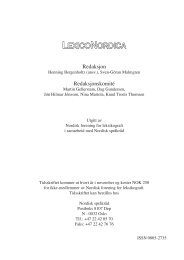- Page 1 and 2: LEXICONORDICA 8 Tidsskrift om leksi
- Page 3 and 4: LEXICONORDICA 8-2001 Redaksjon Henn
- Page 5 and 6: Icke-tematiska bidrag Franziskus Ge
- Page 7 and 8: 1 Henning Bergenholtz & Sven-Göran
- Page 9 and 10: 3 levererade de felfria exemplaren.
- Page 11 and 12: 5 Kristín Bjarnadóttir Verbal Syn
- Page 13 and 14: 7 FIGURE 1. Excerpt from the 1983 e
- Page 15 and 16: FIGURE 3. The entry for bein (ÍO 2
- Page 17: 11 occur, without any information o
- Page 21 and 22: 15 FIGURE 8. The entry for henda (
- Page 23 and 24: 17 hann. 6 The information on those
- Page 25 and 26: 19 FIGURE 13. The entry for batna (
- Page 27 and 28: 21 5. Conclusion The decision to gi
- Page 29 and 30: FIGURE 16. Sample entries from olde
- Page 31 and 32: 25 Ilse Cantell Ordboksplanen för
- Page 33 and 34: 27 A. Projektplanen för Svensk-fin
- Page 35 and 36: 29 Ordboksplanen är en exaktare be
- Page 37 and 38: 31 • ett fåtal väletablerade sl
- Page 39 and 40: 33 4. Genuint ändamål, ordboksfun
- Page 41 and 42: 35 adb/IT administration biologi ek
- Page 43 and 44: 37 besöksförbud lähestymiskielto
- Page 45 and 46: 39 &Suom 3 työsuojeluvaltuutettu
- Page 47 and 48: 41 Semantiska informationstyper (an
- Page 49 and 50: 43 NLO 1997 = Bergenholtz, Henning
- Page 51 and 52: 45 Turid Farbregd & Hannele Seppine
- Page 53 and 54: 47 stor del av opplaget vart seld i
- Page 55 and 56: 49 det blir meir tale om kva ein li
- Page 57 and 58: 51 nettopp til Perussanakirja, elle
- Page 59 and 60: 53 sjølvstendige ord. På andre si
- Page 61 and 62: 55 vart FNO 2000, gjekk dei derfor
- Page 63 and 64: 57 og velja samlande former. Dessve
- Page 65 and 66: 59 bokmålet ser ut i dag, måtte v
- Page 67 and 68: 61 FNO 1993 kan hoppa over probleme
- Page 69 and 70:
63 5. Tillegg: Norsk morfologi i Fi
- Page 71 and 72:
65 2. Adjektiv 2.1. Adjektivbøying
- Page 73 and 74:
67 Nynorskordboka = Marit Hovdenak,
- Page 75 and 76:
68 ordboksbeskrivning som uppfyller
- Page 77 and 78:
70 2. Språkhistorisk släktskap ka
- Page 79 and 80:
72 4.1. Det semantiska fältet FJÁ
- Page 81 and 82:
synonymer till den sökta enheten o
- Page 83 and 84:
76 bru›la sóa slösa, ödsla sl
- Page 85 and 86:
78 Fjárhagsástand 1.1. Gó›ur f
- Page 87 and 88:
80 komast í flrot vera kominn í f
- Page 89 and 90:
82 denna betydelse främst uttrycks
- Page 91 and 92:
84 En klassificering som bygger på
- Page 93 and 94:
86 den angivna motsvarigheten är e
- Page 95 and 96:
88 Sådana skillnader i ordens egen
- Page 97 and 98:
90 eiga bágt me› a› ∅ ERFI
- Page 99 and 100:
92 1. Ordboken utgår i grunden fr
- Page 101 and 102:
Kromann, H.-P., Th. Riiber och P. R
- Page 103 and 104:
94 Eg har for det meste avgrensa me
- Page 105 and 106:
96 Om tospråkleg leksikografi i No
- Page 107 and 108:
98 Nordisk språksekretariat gav ut
- Page 109 and 110:
100 Ordboka er rik på (nord)norske
- Page 111 and 112:
102 Her har lista frå Nordisk spr
- Page 113 and 114:
104 karar vil denne måten å velje
- Page 115 and 116:
106 Gjennomgåinga av dei undersøk
- Page 117 and 118:
108 Orgland, Ivar og Raastad, Frede
- Page 119 and 120:
110 2. Andre ordbøker Bergenholtz,
- Page 121 and 122:
111 Birgitta Lindgren Håller princ
- Page 123 and 124:
113 mest kända är rolig, som i da
- Page 125 and 126:
115 Eftersom ordboken är avsedd so
- Page 127 and 128:
117 AB sv da, no A/S ad da no langs
- Page 129 and 130:
119 Att ordboken är trespråkig oc
- Page 131 and 132:
121 FIGUR 15. Från svenska listan
- Page 133 and 134:
123 lömskt ord. Det kan inte vara
- Page 135 and 136:
125 Bolette Pedersen, Ruth Vatvedt
- Page 137 and 138:
127 ontologin med hjälp av en is-a
- Page 139 and 140:
129 Den uppgift inom lexikografin i
- Page 141 and 142:
131 2.3.2. Norsk ekvivalent med ann
- Page 143 and 144:
133 naming="sjofel" namingN="uanste
- Page 145 and 146:
135 lertid koncentrerat oss på pro
- Page 147 and 148:
137 Som exempel på metalänkning k
- Page 149 and 150:
139 Second International Conference
- Page 151 and 152:
140 i ett språk och deras inbörde
- Page 153 and 154:
142 2. En explicit ordboksgrammatik
- Page 155 and 156:
144 Detta är, som jag ser det, den
- Page 157 and 158:
146 Tanken om en växelverkan och e
- Page 159 and 160:
148 har då följande möjligheter
- Page 161 and 162:
150 lexikaliserade fall av den här
- Page 163 and 164:
152 Satsen betyder att någon står
- Page 165 and 166:
154 Goldberg, Adele E. 1995: Constr
- Page 167 and 168:
156 Haraldur Magnússon & Erik Søn
- Page 169 and 170:
158 Hannele Seppinen: ca. 37 000 Fi
- Page 171 and 172:
160 Birgitta Hylin: Färöord 1984
- Page 173 and 174:
162 lommeordbok 1996 ca. 25.000 ord
- Page 175 and 176:
164 nordsamisk-norsk B. Kåven, J.
- Page 177 and 178:
166 svensk-islandsk Gösta Holm & A
- Page 179 and 180:
167 Franziskus Geeb eXtensible Mark
- Page 181 and 182:
169 arbejde med indholdet og dens s
- Page 183 and 184:
171 XML tilbyder ved siden af et me
- Page 185 and 186:
173 gel for den konkrete brug af de
- Page 187 and 188:
175 trælignende visning af XML-fil
- Page 189 and 190:
177 form Ressource Identificator (i
- Page 191 and 192:
179 side vil produktionen af leksik
- Page 193 and 194:
181 brugen af XML som datagrundlag
- Page 195 and 196:
183 Möhr, Wiebke und Ingrid Schmid
- Page 197 and 198:
184 århundre. Ordene satan, alter
- Page 199 and 200:
186 Det ville vel vært det riktigs
- Page 201 and 202:
188 Skanner, skanning uttales ikke
- Page 203 and 204:
190 Den äldre Helsingforsslangen
- Page 205 and 206:
192 De som intresserar sig för sla
- Page 207 and 208:
194 Sörkan bärtsit (om klippor i
- Page 209 and 210:
195 Dag Gundersen Nyord Jarvad, Pia
- Page 211 and 212:
197 språk som har vært først ute
- Page 213 and 214:
199 N D S (begge utg.; N =ordet st
- Page 215 and 216:
201 finne eksempler på det. I fort
- Page 217 and 218:
203 Moberg, Lena (hovedred.) 2000:
- Page 219 and 220:
204 and, especially, NODE have cons
- Page 221 and 222:
206 Som bakgrund till en mer detalj
- Page 223 and 224:
208 Collins här är nästan dubbel
- Page 225 and 226:
210 lexikonen (utgivningsår 1998-9
- Page 227 and 228:
212 business) 'E-handel mellan för
- Page 229 and 230:
214 uses of a word have tended to l
- Page 231 and 232:
216 använder sig av begreppet, doc
- Page 233 and 234:
218 utreds bl.a. skillnaden mellan
- Page 235 and 236:
220 användaren. 18 Båda använder
- Page 237 and 238:
222 dem är att samtliga skiljer me
- Page 239 and 240:
224 hänvisas sålunda till roten g
- Page 241 and 242:
226 det också, vid sidan av tidnin
- Page 243 and 244:
228 1980-talet även kommit att anv
- Page 245 and 246:
230 wheel drive') och .rw (American
- Page 247 and 248:
232 varför Billie Holiday, jazzens
- Page 249 and 250:
234 ordböcker skulle definitivt va
- Page 251 and 252:
235 Emma Sköldberg Bevingat - en n
- Page 253 and 254:
237 modersmål än det svenska och
- Page 255 and 256:
239 Trots dessa brasklappar återko
- Page 257 and 258:
241 "Vore gott att I gode män …
- Page 259 and 260:
243 uttryck som tillkommit efter Ho
- Page 261 and 262:
246 främsta ordboksförlag självf
- Page 263 and 264:
248 samma omfång som Barezzani-Kal
- Page 265 and 266:
250 ylennystä 'försöka bli befor
- Page 267 and 268:
252 italienska delen ges alldeles r
- Page 269 and 270:
254 här områdena. I fråga om nat
- Page 271 and 272:
256 bristen. Mycket värre är inko
- Page 273 and 274:
258 Övriga ordböcker DISC, dizion
- Page 275 and 276:
260 Behovet av främmande ord De fl
- Page 277 and 278:
262 Det följande avsnittet innehå
- Page 279 and 280:
264 met. Alla de här nybildningarn
- Page 281 and 282:
266 Vanliga ord som anpassats till
- Page 283 and 284:
268 TS = Tietosanakirja 2 (1910) oc
- Page 285 and 286:
270 tragtning af temaet ville det n
- Page 287 and 288:
272 netop var repræsentanter for d
- Page 289 and 290:
274 ILLUSTRATION 1: Anna-Lena Buche
- Page 291 and 292:
276 og præsentationsformer internt
- Page 293 and 294:
278 stiller sig ud fra et brugersyn
- Page 295 and 296:
280 första principen baserar sig p
- Page 297 and 298:
282 mest af alt minder om de rappor
- Page 299 and 300:
283 Trond Trosterud Stor norsk-sami
- Page 301 and 302:
285 jutud 5 (tid:) kuluma [27]; tid
- Page 303 and 304:
287 eller festet; tykkenden av noe
- Page 305 and 306:
289 kabaret, kabelbane, kabelfjerns
- Page 307 and 308:
291 dahkahit (forårsake) som andre
- Page 309 and 310:
293 ta istus autosse; hun gikk i kj
- Page 311 and 312:
295 For han og hun oppgjev NSO son.
- Page 313 and 314:
297 stole på. Ser vi bort frå dei
- Page 315 and 316:
299 setjingane. Desse norskspråkle
- Page 317 and 318:
301 I denne artikkelen er teksten f
- Page 319 and 320:
303 opp leksikalsk geografisk varia
- Page 321 and 322:
305 setningane står i kursiv. Ut o
- Page 323 and 324:
307 snart kjem både ei stor einspr
- Page 325 and 326:
308 Povl Skårup Donsk-føroysk or
- Page 327 and 328:
310 Inkomna böcker från oktober 2
- Page 329 and 330:
312 källor och relevant språkvete
- Page 331:
Mugdan, Joachim 1985a: Grammatik im


